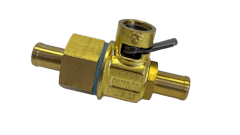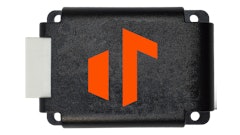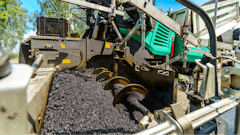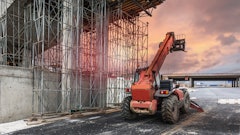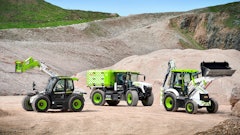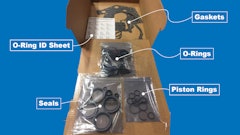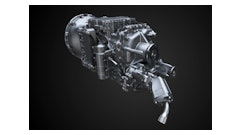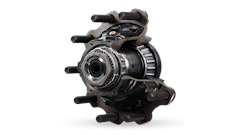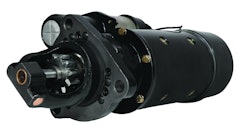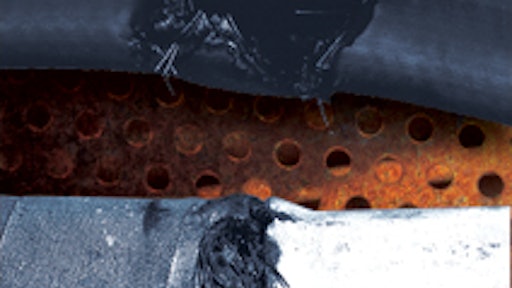
Hydraulic hoses convey liquids under extremely high amounts of pressure. When compromised, they can cause everything from burns, fires and explosions to electrical shock, fluid injections under the skin and even death.
"A lot of people may not understand the danger of hydraulics under pressure," says Scott Kane, regional sales manager for Parker Hannifin. "There is a tremendous amount of energy that is released if a hose bursts or a fitting comes apart. People who work around hydraulics every day can become desensitized to the hazards. But hydraulics can be dangerous and should be respected."
Dave Pooley, national service manager at Hyundai, recalls an incident where a mechanic was checking for an oil leak with his bare hand. "He couldn't see the wet spot, so he was using his hand to feel for it," he says. "He didn't know there was a small hole with oil leaking out at 5,000 psi. The oil penetrated his finger. Today, 12 months later, his finger is the size of a Coke can and he has to make the decision about whether or not to amputate it. In the end, he may lose not only his finger, but his whole hand. Whenever you do anything with hydraulics, you need to put safety first."
What to look for
Safety starts with knowing — and implementing — the proper procedures for inspecting hydraulic hoses. At the very minimum, wear safety glasses and gloves, though Kane indicates even heavy work gloves won't protect you from leaks at extremely high pressures. "Don't put any part of your body where you suspect a hydraulic leak," he emphasizes.
If you want to inspect a hose assembly while the machine is operating, use a clean, thick object or, better yet, sheet metal as a detection device. If you identify a leak, shut down the machine before loosening or removing any hoses or fittings. If you're using an attachment, lower it to the ground to remove any stress on the cylinders. Also shut down the machine if you intend to take apart a valve or inspect a cylinder or pump.
According to a technical report by the International Organization for Standardization, there are several areas to monitor when inspecting hydraulic hoses and assemblies. If any of these conditions exist, the hose assemblies should be evaluated for correction or replacement.
- Leaks at hose fitting or in hose — Weepage and leaks are warning signs of a problem. Connection points are a common source for hose failures because this is where the most wear and tear occurs. "This is especially true for machines such as excavators where there is an articulating point like a boom, arm or bucket," says Pooley. "The hoses flex at these points. Although that's what they're designed to do, there is definitely a lot of wear and tear where the hose goes into the flange."
- Damaged, cut or abraided cover — The cover's job is to protect the reinforcement. "If the cover is worn away, the reinforcement is exposed and the hose will fail a lot sooner," says Kane. Abraided covers are typically caused by improper routing. "Hydraulic hoses should never rub against anything."
Where abrasion is unavoidable, consider abrasion-resistant hoses and hose guards, says Mike Watts, marketing manager for Goodyear's hydraulic hose program. "We offer severe application hoses that are manufactured with a protective coat to offer abrasion resistance over standard rubber-covered hose," he says. "Or you can utilize a nylon sleeve or plastic wrap to offer added protection against abrasion, heat, slag, weld spatter and other harsh environmental conditions."
- Exposed reinforcement — Most high-pressure hoses are reinforced with high-tensile steel, which supplies the ability to handle high pressures. "If the steel is exposed, it will rust fairly quickly with exposure to rain and humidity," says Kane. "When that happens, it decreases in strength. Even though there are multiple layers, once a wire breaks or fails, it transmits the rest of the load to the other wires. It starts a domino effect. Eventually, the wire will burst and the hose will fail."
- Kinked, crushed, flattened or twisted hose — Most kinks and twists are the result of a routing problem. All hoses are designed with a minimum bend radius. "When you exceed the bend radius, you put excessive stress on the wire, which can shorten the life of the hose," says Kane. "Plus, if a hose has to strain or bend tightly, it's an early warning sign that it will eventually fail."
"Proper routing is an area where you can make a hose last longer or wear faster," notes Mike McGreevy, application engineer at Parker Hannifin. "If the material is stressed for whatever reason — due to a twist, strain or excessive bend — the inner tube can tear apart, and like anything that bends too far, it will eventually break."
- Hard, stiff, heat cracked or charred hose — Excessive heat can decrease a hose's flexibility. Temperature-related failures usually can be seen by a hardening of the hose cover, cracking and the hose assembly taking a permanent set in the shape it was routed, says Watts.
It is important to consider both internal and external temperatures, as well as routing. "The outer cover can be damaged by routing a hose too close to a hot manifold," Watts says. "Cracking of the hose compounds is caused by the plasticizers leaching out when you exceed compound design temperature."
In high-heat applications, use a special hose or a cover. "Most 'vanilla' hoses are rated to about 200° F for fluid temperatures inside the hose, as well as the ambient temperature outside the hose," says Kane. "It's a good idea to keep the hydraulic system operating under 150° F. At temperatures above that, you'll not only have problems with hoses, but also O-rings, seals, etc."
Cracking can also be caused by age. "Rubber has a limited shelf life," says Pooley. He suggests changing hoses every three to four years, regardless of their condition. "During normal work and operation, there is a lot of stress and strain on a hydraulic system. The hose is what takes the brunt of it. It will wear internally and externally from weather, application, movement and, of course, pressurization. There is a point in time when a hose has reached the end of its useful life. By switching out hoses on a timely basis, you can divert a lot of dangerous problems that could occur."
- Blistered, soft, degraded or loose cover — Bubbles in the cover are an indication that there is likely a leak in the inner tube, and the hydraulic fluid has worked its way through to the cover.
A soft, spongy cover can indicate chemical incompatibility. "Hoses are designed to work with a particular type of fluid," Kane explains. "If you use the wrong one, or if the wrong fluid splashes on the outside of the hose, it will attack the rubber and the hose should be replaced."
Daily hose checks
It's a good practice to inspect hydraulic hoses as part of the daily preventive maintenance routine. "Check around your machine and look at all the hydraulic hoses," advises Pooley. "You'll be able to see most of the hoses from the ground. And when you lift the hood, you'll be able to check the rest."
Pay particular attention to hoses when working in extreme conditions, such as demolition or brush clearing. "There is a lot of debris falling and flying around in these applications," Pooley says. "It's important to be aware of the environment you're working in."
If damage is detected, it's better to be safe than sorry. "Any time you have concerns about assembly integrity because of potential damage, it should be replaced," Wren states. "Downtime on the jobsite is much more costly than replacing the assembly during your routine inspection."




